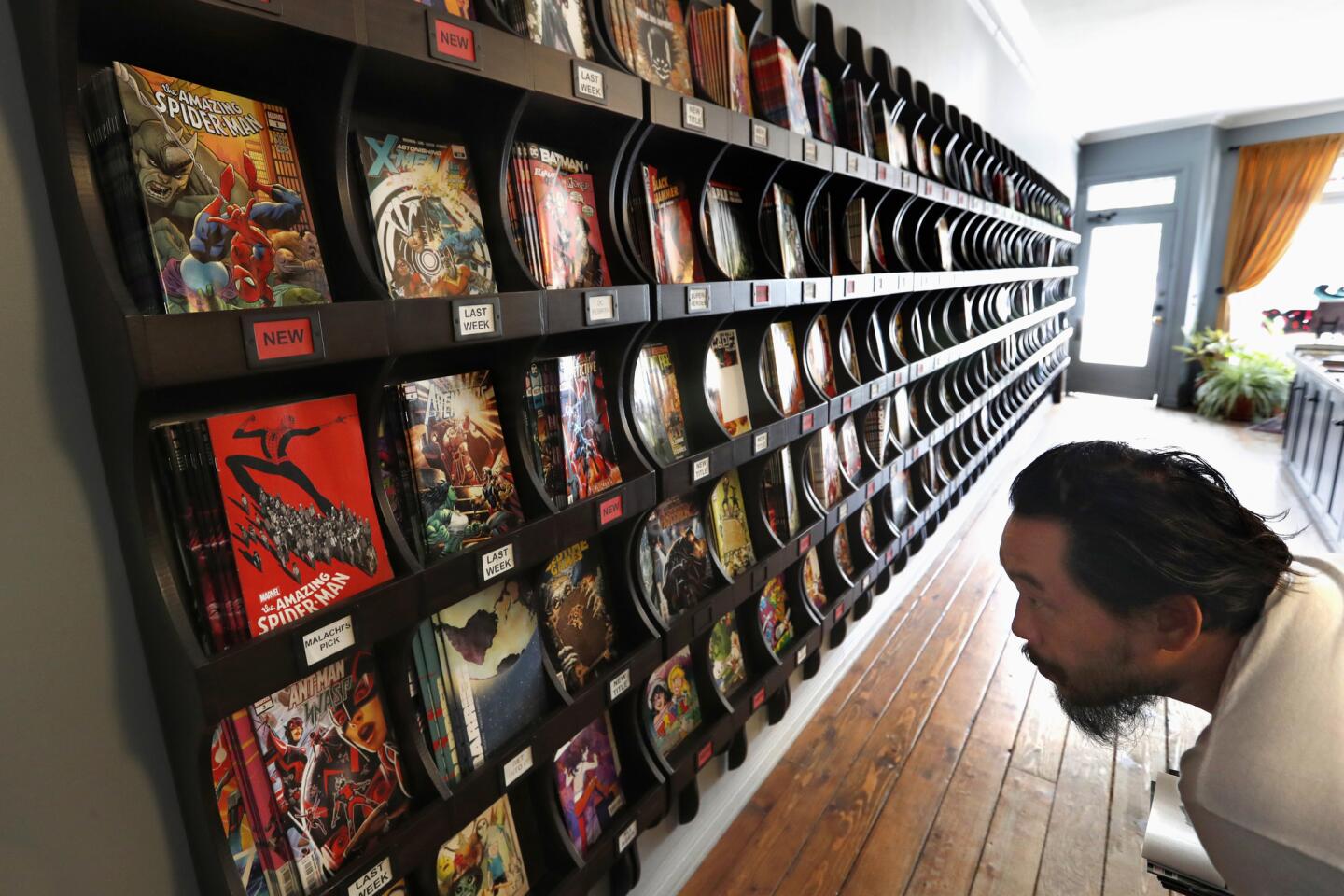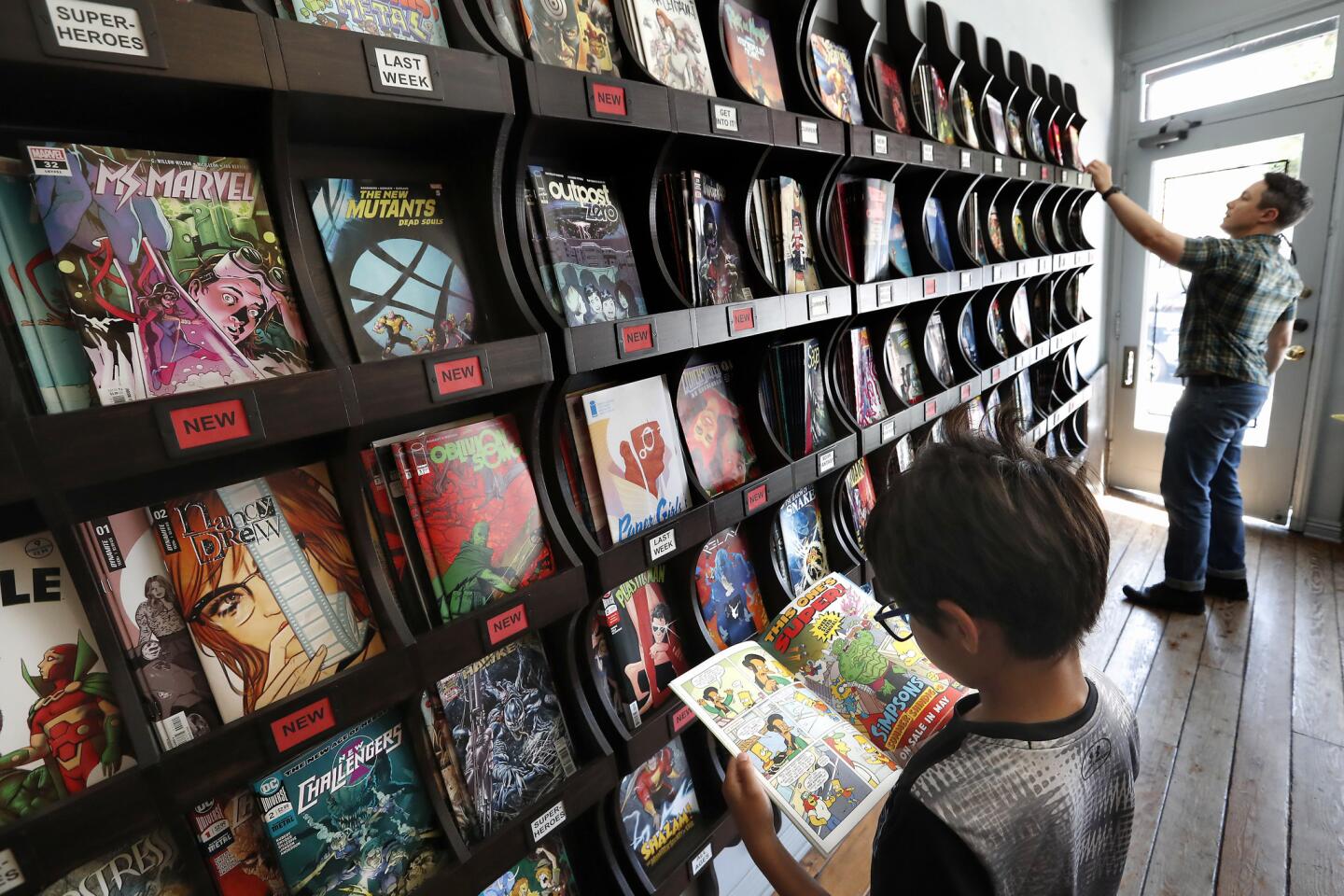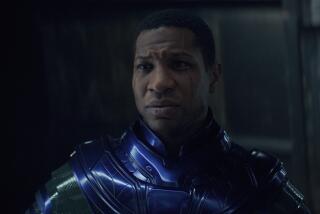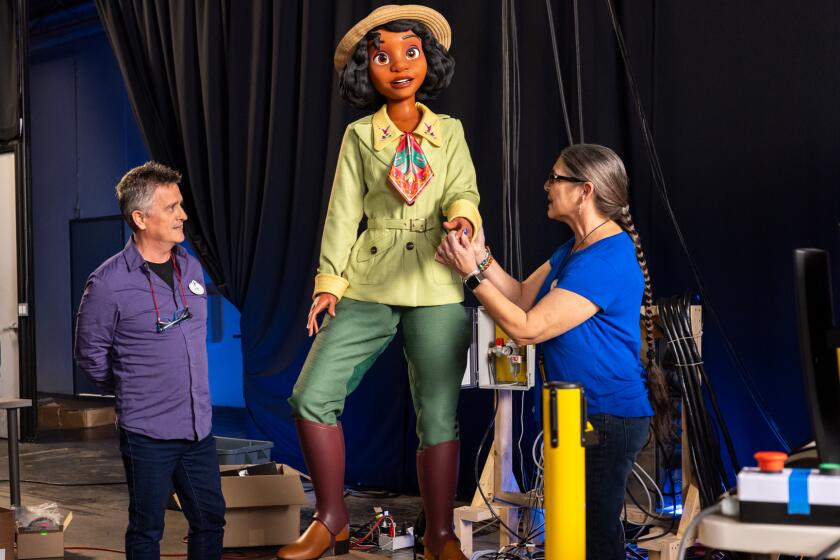Must Reads: Superheroes are thriving in movies and on TV — but comic books lag behind
There is no hotter commodity in pop culture than Marvel Comics superheroes. They’re the powerhouse behind four hit films this year (including the top two in global box office, Disney’s $3.6 billion tandem of “Black Panther” and “Avengers: Infinity War”) and on television they’re featured in 10 live-action series spread across ABC, Fox, Netflix, FX, Hulu and Freeform as well as five more animated franchises.
Don’t expect a break during the commercials, either, where Marvel creations are the costumed pitchmen for Ford, Geico, Infiniti and Rocket Mortgage.
For the record:
12:30 p.m. July 16, 2018This article says Disney bought Marvel for $9 billion. The acquisition was for $4.2 billion.
There is one sector, however, where Marvel heroes are not soaring to new heights, one in which they struggle to find new fans — and in a wry twist, it’s in their original medium, in the pages of Marvel Comics.
Marvel comic books, which introduced the world to such characters as the Avengers, Spider-Man, the X-Men, Deadpool and Venom, is still the brand to beat in its sector — over the past decade, Marvel has locked down the No. 1 spot in its annual market share competition with rivals including DC Comics, Image and Dark Horse.
But the picture is less rosy when Marvel competes with its own past. Today’s comics sell one-tenth the numbers Marvel expected in the 1960s and 1970s glory days when comic books were cheaper than candy bars and just as easy to find at the nation’s newsstands, corner markets and drugstores.
Now, a new comic book costs $4-$6 and the only shelves they reach are at the 2,500 comic book specialty shops doing business in the U.S. and Canada — and even that number is in decline as stores (among them Meltdown Comics, the Sunset Boulevard landmark of 25 years) lose their leases or downsize to online merchants.

There’s an even steeper challenge: For young consumers, could any comic book ever stack up against video games, smartphones and Pixar films?
All monthly comics by Marvel, DC and other leading publishers reach readers through Maryland-based Diamond Comics Distributors, which reported that in 2017 single-issue sales were down more than 10%, while graphic novels (which reprint the most popular multiple-issue storylines into the “trade paperback” format sold at bookstores) were down more than 9%.
Next week, the New York-based Marvel Comics will bring its top creative talent to Comic-Con International in San Diego, the largest pop culture convention in the world. Fans will hear about major new publishing directions for Captain America and the Fantastic Four as well as plans for the company’s 80th anniversary celebration in 2019.
Marvel will be thrilled by any celebration after a bumpy 2017 in which it endured a minor retailer revolt (due to ordering policies on high-demand releases) and then sparked a cultural debate (when an executive blamed diversity efforts for sales setbacks).
The year ended on a happier note with respected industry veteran C.B. Cebulski taking the reins as editor in chief, a move hailed widely as a good step toward energizing a brand that, in recent years, has been vague in its editorial vision amid notable talent defections.
The panel presentations will put Marvel editors face to face with impassioned longtime fans (many of them dressed in tights) who, like “Star Wars” followers, veer between fawning or furious but are never apathetic.
The diehard Marvel readership were nicknamed “True Believers” back in the 1960s when the publisher promoted itself as “the House of Ideas” and boasted a legendary staff bullpen (led by Stan Lee, Jack Kirby, Steve Ditko and John Buscema). They introduced a level of melodrama, humor and trippy cosmic mythology that instantly reinvented the staid superhero template that had been set in the FDR era by Superman, Batman and Wonder Woman over at archrival DC Comics.
Like today’s Marvel films, the energy of those 1960s comics issues won over a wider and older audience than previous superhero fare; in a 1965 poll of college campuses by Esquire, both Spider-Man and the Hulk joined Che Guevara and Bob Dylan in a ranking of favorite counter-culture icons. Marvel in the 1960s energized the entire comics industry by winning over an audience that was more grown-up but now (with a fan base of collectors in their 30s), the publisher’s readership is growing old.
The monthly comics are written to appeal to longtime fans, which means they often have very little in common with the current storylines of films such as Disney’s just-released “Ant-Man and the Wasp” or television shows such as “Legion,” “Daredevil,” “Punisher” or “Jessica Jones.”
The movies aren’t rescuing the comics; they’re replacing them.
— Michael Uslan, comic book writer
Curious fans of the screen heroes that manage to find a comic book store might not recognize the heroes they find in their namesake comics. (In the case of Netflix’s “Luke Cage,” the same character that merits his own television series wasn’t popular enough to hold to his own monthly comic book.) At Comic-Con, the Marvel television shows will be packing fans in to panel presentations with stars, but they will be separate and unconnected to the panels for comics readers. (The cinematic Marvel stars and filmmakers will not attend this year’s expo in San Diego at all, a testament to their secured spot as a commercial dynamo that no longer needs the promotional opportunities of Comic-Con.)
It adds up to a frustrating disconnect, according to Heidi MacDonald, editor in chief of the Beat, a comics industry blog.
“With Marvel Comics, they’re definitely down from where they were five years ago even as the movies have gotten huge,” MacDonald said. “But over that time, they have also been No. 1 in the direct market for something like 99% of the time. So their point of view is, ‘If it ain’t broke, don’t fix it.’
“The movies and, to a lesser extent, the television shows have made Marvel a household brand name and when you have a film that is tied closely to a specific storyline — like [the Fox film] ‘Logan,’ which was based on the graphic novel ‘Old Man Logan’ — there is definitely interest in that title. But when you see the brand power outside of comics the question people ask is ‘Are they doing as much as they could with that?’”
Few people in Hollywood have more history with comic books adaptations than Michael Uslan, who began writing comic books in the 1970s and used that expertise as an executive producer on Tim Burton’s “Batman,” the 1989 hit that launched a new generation of superhero movies. Uslan recalled recently that top Marvel Comics executives treated him to a lavish Manhattan meal after the movie stirred fan interest in all comics and gave Marvel a hefty spike in sales.
“That was the case for years, big superhero movies brought new fans to comics, but it’s not the case now,” Uslan said. “The biggest comic book movies now have little or zero impact on the comics sales. The movies aren’t rescuing the comics; they’re replacing them. So now I really worry about comics. Any entertainment medium that can’t connect with new generations, doesn’t it have one foot in the grave?”
Uslan and most longtime observers agree that on paper, at least, the future of Marvel appears far smaller than its past but that’s not a world view shared by Dan Buckley, the president of publishing for Marvel Entertainment and an industry veteran who responds to the chorus of doomsayers with a survivor’s chuckle.
“I’ve been managing over the demise of the print comic book business since 1991,” Buckley said. “That’s all anyone has talked about — how this is going to end. I find it fascinating that there’s a certain cynicism built into the beast. I’ve been fighting against it for a really long time.”
The truth, he says, is that, “it’s a pretty fabulous business to be in.”
Buckley cites history and experience to back up that opinion. Marvel is a company that has endured bankruptcy, a disastrous debut effort in Hollywood (remember “Howard the Duck” in the 1980s?) and certain death back in the Reagan era when “funny books” lost their best chance to reach youngsters across America. When glossy magazines and retailer priorities pushed comics out of mainstream stores in the 1980s, the industry was saved by devoting itself to the “hobby market,” as Buckley calls it, adding that “the hobby business is a wonderful business to be in too, one we’re thankful for.”
The superhero comic book is (like jazz, baseball and hip-hop) a uniquely American creation, but it’s a foreign object to most youngsters today.
There are few places where kids might even bump into one by accident — Marvel’s monthly issues aren’t sold at Target, Barnes & Noble or even 7-11, where, in recent weeks, you could have found Marvel’s fan-favorite character Deadpool on every Slurpee machine in America but nowhere on the magazine rack. At movie theaters Fox’s “Deadpool 2” is the biggest R-rated film of 2018 — but would his comics sell like popcorn if they were available in the lobby?
Privately, some comics creators say they view themselves as the R&D departments for Disney (which bought Marvel for $9 billion in 2009) and Warner Bros (which owns DC Comics) and judge their content’s value as intellectual property, not as a publishing venture.
DC Comics is challenging the status quo with a just-announced Wal-Mart partnership. The retail giant will sell four different 100-page monthly anthologies of comics stories (mixing reprints with some new and exclusive content) that will not be sold to comics shop. The move was met with complaints from the comics shop community and curious interest by rival publishers, making it a topic of high interest next week in San Diego.
Technology has helped somewhat in the form of digital comics, but after a decade on the scene, the screen versions of comics have been a middling success at best and even there, again, the in-demand product is primarily tailored to the sensibilities of longtime collectors, not newbies.
When Marvel got into the digital game back in 2007, a reporter for The Times asked Buckley about the key challenge facing his company. “We don’t have a natural lifestyle interaction point for kids anymore,” he said. Reminded of the quote by the same reporter, Buckley admitted that not much has changed over the past decade. “I was right when I said that and, you know, I’d be right if I said it again.”
More to Read
The biggest entertainment stories
Get our big stories about Hollywood, film, television, music, arts, culture and more right in your inbox as soon as they publish.
You may occasionally receive promotional content from the Los Angeles Times.








